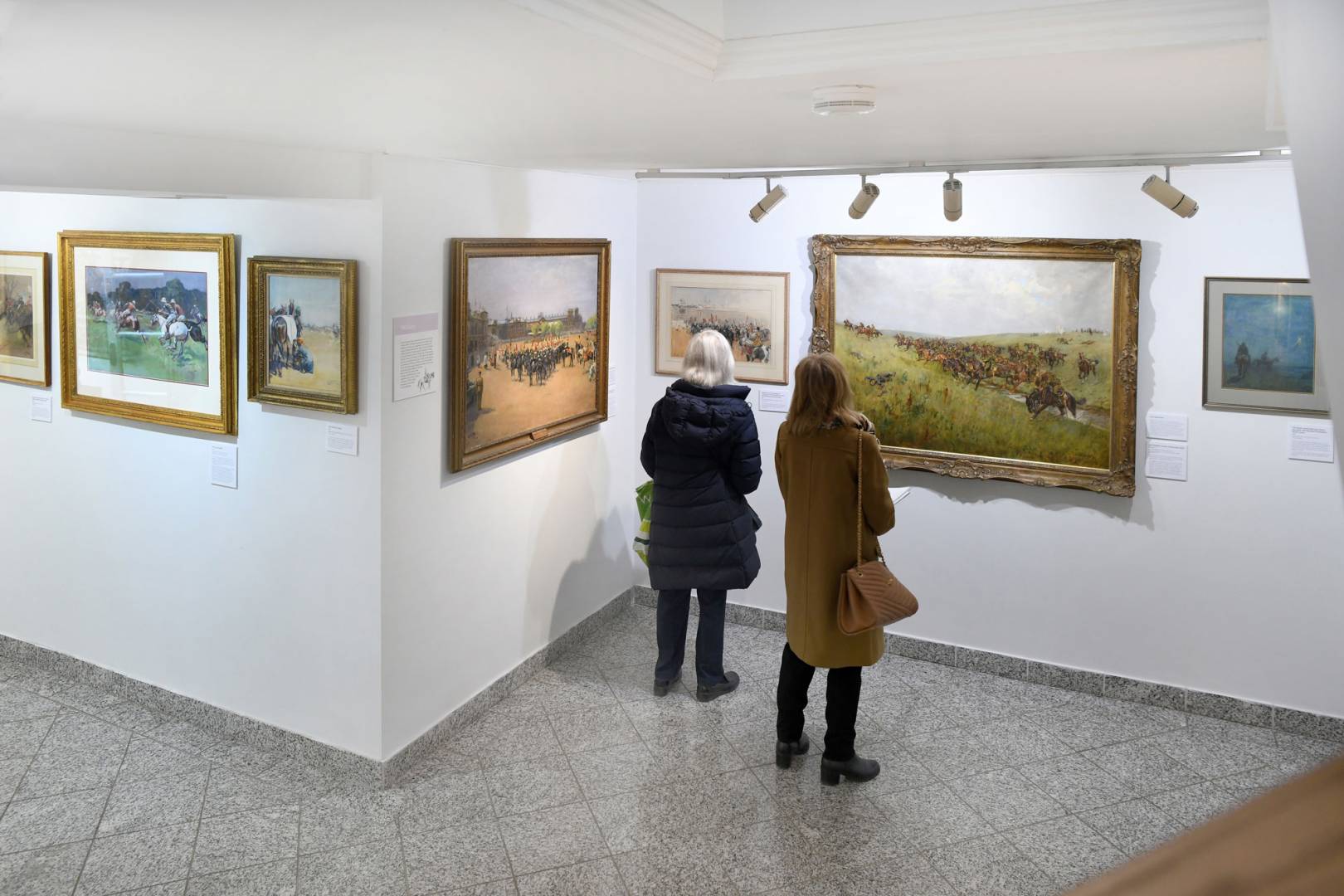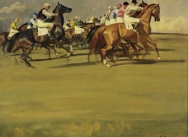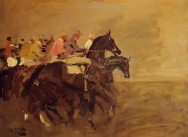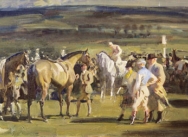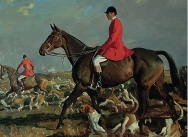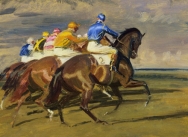A to Z of artists Munnings PRA, Sir Alfred 1878 - 1959
Born on 8 October 1878, the second of four sons of a yeoman milling family in Mendham on the boundary of Norfolk and Suffolk, Munnings had a chequered schooling. Showing a strong desire to draw and paint, he was apprenticed at the age of fourteen to a firm of Norwich lithographers for six years. Here he learnt the disciplines of precise drawing and the use of colour while each evening spending two hours at Norwich School of Art. His tutor, Walter Scott, was one of three people to significantly influence the young painter’s outlook on art and life. The others were James Reeve, then curator of Norwich Museum, and John Shaw Tomkins, the managing director of A.J. Caley & Sons who became a steadfast patron. His first paintings to be hung at the Royal Academy, in 1899, were Pike Fishing and Stranded, the latter of his small twin cousins in a rowing boat stuck fast in the sedges of the River Waveney. In the same year his Cloudy Weather was exhibited at the Royal Institute of Painters in Water Colours. Painting mainly in the open air, his subjects soon widened to embrace horses, ponies, cattle, local race meetings and country fairs, each with a sense of light and free handling of paint which today classes him as an important exponent of English Impressionism. In 1900 he lost the sight of one eye but undeterred soon adapted to this lifelong disability. He made two short visits to the Atelier Julian in Paris. He was drawn to Cornwall and the work of the Newlyn artists first as a visitor but later settling for a short time at Lamorna in 1913. It was in this year that he held his first one-man show at the Leicester Galleries in London. It was also at this time that his long admiration of gypsies led to annual visits to their camps while they were hop-picking in Hampshire, culminating in successful exhibitions in London in 1920 and 1921. Rejected by the army at the outbreak of the First World War due to his defective eyesight, Munnings was employed for a time at a Remount Depot, (with Cecil Aldin (q.v.)). He was later selected as a war artist to record the activities of the Canadian Cavalry Brigade in France in 1917 and 1918. An increasing number of commissions to paint equestrian racing and hunting portraits followed an exhibition of his war paintings held in London in 1919. A visit to the United States in 1924 added to these demands on his time. His volatile and gregarious character (sometimes hiding depression) and absences while painting may have been partly responsible for the suicide of his first wife in 1913. In 1920 he married an accomplished horsewoman, Violet McBride, who brought stability, encouragement and order to his hectic life. His work was exhibited at the Paris Salon (Gold medals in 1922 and 1925) and each year at the Academy where he was elected an Academician in 1926. For the next twenty years his life comprised a ceaseless round of painting racing and hunting portraits, and chafing at the few opportunities allowing him to paint what he wanted to paint. He was knighted in 1944, the year he was elected President of the Royal Academy. Outspoken and uncomfortable in this appointment, he upset his academician peers by an unforgettable tirade against modern art during his last annual dinner speech as President in 1949. He continued to paint Thoroughbreds and the hunting world despite being afflicted by attacks of gout. His three-volume autobiography: An Artist’s Life, The Second Burst and The Finish was published in the early 1950s. His last commission, in 1953, was to paint Her Majesty the Queen’s racehorse Aureole which had come second in the Derby that year. Despite the continuing animosity over his Academy speech, a retrospective exhibition of his work was held at the Royal Academy Diploma Gallery in 1956. Living at Castle House, Dedham for over thirty years, he died there on 16 July 1959. His ashes lie next to the memorial to his fellow countryman and artist, John Constable.
Other works of art you may be interested in
Copyright © 2025 BSAT, All rights reserved
This website uses cookies and similar technologies to give you the very best user experience, including to personalise advertising and content. By clicking 'Accept', you accept all cookies.


